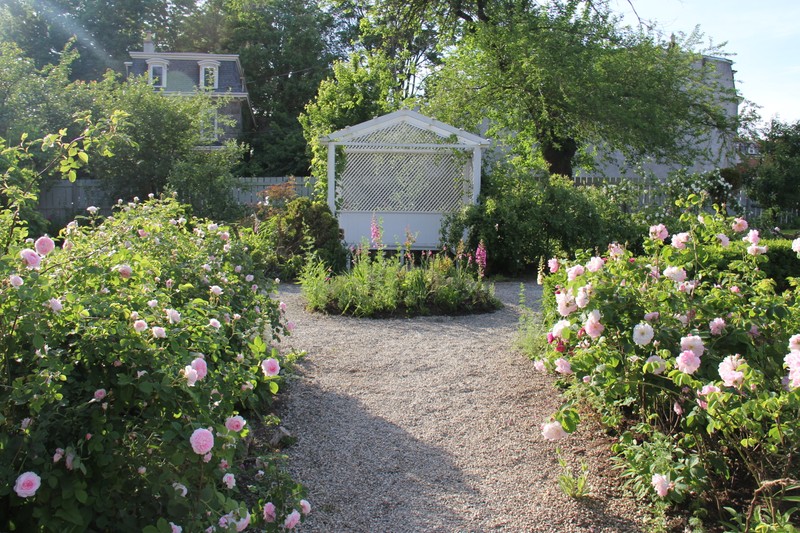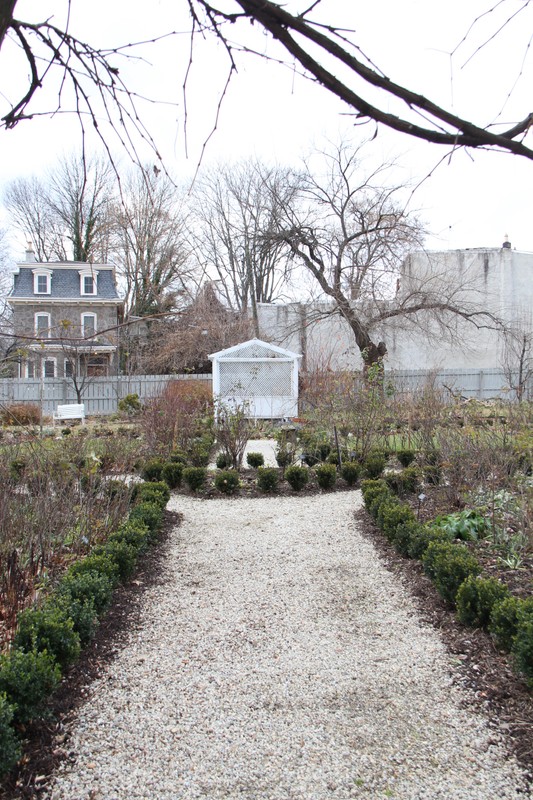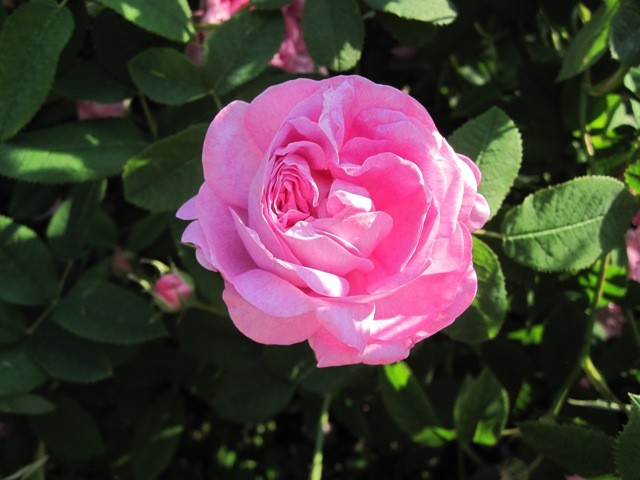Wyck Rose Garden
Introduction
Text-to-speech Audio
Images
The garden in bloom facing the summerhouse.

The garden in early spring.

A 1915 photo of the central medallion in the garden, looking quite overgrown.
.jpg)
The garden with the freshly planted Little Missy boxwoods, installed in 2019

The Lafayette Rose

The Elegant Gallica Rose

Backstory and Context
Text-to-speech Audio
Jane Bowne Haines (1790 - 1843) moved from her family home in Flushing, New York to Philadelphia in 1812 to marry a man from another prominent Quaker family, Reuben Haines III. Reuben had inherited Wyck upon the death of his father, Caspar Wistar Haines, in 1802. A few years into Jane and Reuben's marriage they decided to relocate from their home in downtown Philadelphia to Reuben's family home, Wyck. Wyck was located miles from the city in Germantown and Jane was disappointed by the estate's lack of a scenic vista and formal gardens - she longed for a space to entertain her guests. In 1821, she designed this rose garden to provide a space to socialize and to soak up the beauty of nature. The garden was installed and the house was renovated by noted architect, William Strickland. By 1825 the upgraded estate was fit to host the Marquis de Lafayette on his travels through Germantown.
The Oldest Roses
The oldest roses in the garden are thought to have been planted in the 18th century as medicinal plants, including the stand of Rosa alba semi-plena (located to the right of the seating area known as the summerhouse). This variety dates to before 1629 and is thought to be the rose symbolizing the House of York during the War of the Roses in England. Extremely fragrant and bearing large quantities of rose hips later in the season, this rose was used often in medicinal applications during the Colonial era. Another rose of great antiquity in Wyck’s garden is ‘Pink Leda’, a damask rose that the first European settlers brought to America. A rose with deep roots locally, the ‘Celsiana’ was growing in Germantown by about 1750. It went by the local name Germantown Damask; it was also known as the Tobacco Rose because its fragrant petals were added medicinally to tobacco. Wyck’s garden also features the dowager of all old European roses, Rosa gallica officinalis, along with the striped sport ‘Rosa Mondi’. R. gallica officinalis has been cultivated since the Crusades. Also called the Apothecary Rose, it was highly valued for its medicinal properties historically.
Mystery Roses
Several roses in the garden are mysteries. Among these is the ‘Elegant Gallica,’ a variety that would have been fully extinct had it not survived at Wyck and eventually been propagated for distribution commercially. An even rarer rose is ‘Lafayette,’ a gallica/damask hybrid which is available only through Wyck. It is believed to have been planted in honor of the Marquis de Lafayette’s visit to Wyck in 1825 during a return trip to Philadelphia. The name ‘Bella Donna’ referred to a number of roses throughout the 20th century, and great debates raged as to which rose was the real ‘Bella Donna’! The presence of the rose in Wyck’s garden, along with its name appearing on an early plant list, resulted in a decisive identification.
The Early China Roses
Roses were introduced from China in the late-18th and early-19th centuries. These roses caused great excitement; a rose revolution! Small and twiggy, less hardy, and bearing a scant fragrance, China roses re-bloom regularly, a quality virtually nonexistent in roses up to that time. ‘Old Blush’ was one of the first, along with ‘Slater’s Crimson China’ and ‘Miss Wilmot’s China’. The latter was known in China as White Pearl in Red Dragon’s Mouth. A number of roses in Wyck’s garden represent rose breeding efforts in the 19th century to combine genes from the China roses with those of the old European favorites.
The 19th Century Roses
A number of roses in Wyck’s garden represent efforts in the 19th century to combine genes from the China roses with those of the old European favorites. The oval bed in the center of the parterres contains several such roses, including ‘Marquesa Boccella,’ ‘Victor Verdier,’ and ‘Baronne Prevost.’ Elsewhere in the garden are the similar ‘Rose de Rescht’ and ‘La Reine.’ Although not strong re-bloomers by today’s standards, these roses were considered an important step toward the ever-blooming roses that gardeners were beginning to demand. The first American rose hybrid was created in 1811; it arrived at Wyck by 1824. ‘Champney’s Pink Cluster’ was a cross between the two favorite roses of a South Carolina rice planter, the Musk rose and the China rose. It exhibits the best qualities of both parents, reblooming reliably and more fragrant than many other roses. Climbing roses were not commonly planted until the introduction of the wichuriaina rose from China in the late 19th century. This extremely vigorous plant is very hardy and can grow to 20 feet or more. The hybrid wichuriainas ‘American Pillar,’ ‘Silver Moon,’ ‘Dr. Van Fleet,’ and ‘Tausendschoen’ (the latter found in the lattice on the front of the house) reflect the popularity of climbing roses in the early 20th century.
Cite This Entry
Frydman, Tess. "Wyck Rose Garden." Clio: Your Guide to History. April 23, 2020. Accessed March 14, 2025. https://theclio.com/entry/18603/tour/2/reverse

